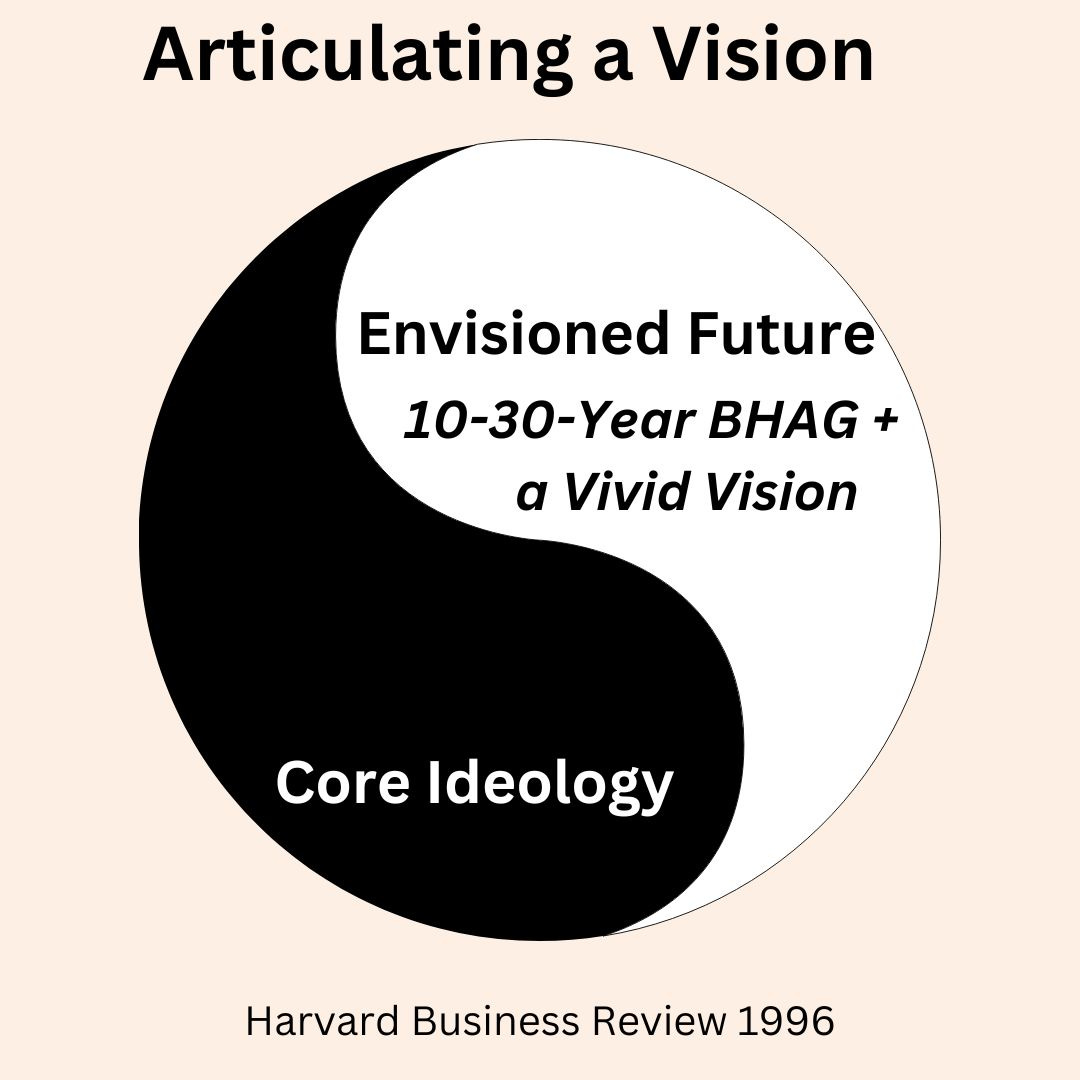About You (the Reader)
Imagine: You find yourself in a strategy retreat or offsite wanting more than the usual same-old limited, short-term thinking.
In fact, your mind is racing with ideas about ways things could be done differently. You have game-changing aspirations. BHAGs. Longer time-horizons. Actions which would pre-empt the competition, or tech trends.
Case studies of Apple, Netflix, Amazon and other industry-leaders fly through your head as you recall stories of moments when they made tough decisions.
But you aren’t sure how to intervene, or even if these examples apply to your organization. So, you stay quiet at critical moments…and suddenly, the workshop is over.
However, as you drive home you keep asking yourself:
“What could I have done differently? Could these meetings be transformed to include a long-term perspective? Maybe even some Innovations? Breakthroughs? Inspirations? New Categories? Unprecedented disruptions to our industry? Why not?”
Maybe you could even engage staff, and somehow access some of the time, energy and effort they put into other places, like Tik Tok, Instagram and Disney Plus.
But where do you start? How do you change the way strategy is made for the better?
Welcome to Jump-Leap Long-Term Strategic Planning- a different category of thinking around strategy that defines conventional wisdom.
A Quick Story
Alberto was fuming, but only inside. A consummate board member, he couldn’t share all the turmoil he felt in this, his first prep meeting for the upcoming strategic planning retreat. He was limited. As the new kid on the block, he was given the chore to represent the board in this routine, annual corporate activity.
But it was clear to him that his new colleagues were simply going through the motions. The end-product, an updated strategic plan, would endorse the path the company had taken for three decades…an amazing unbroken run of success.
Now, he realized, they had been lucky. No real competition had ever shown up. That is, until six months ago when a South Korean company (TTwida) popped up out of nowhere. Boasting new technology, they were scaring the CEO and his board, but few others seemed to care. The planning team certainly didn’t.
He struggled to get some words together that wouldn’t alarm or distress the team.
“But if we only plan for the next three to five years, how will we ever incorporate the latest technologies - like the ones TTwida is using?”
“It’s not our job to plan for the future. Just put together the strategic plan” the team leader explained.
His pained expression and reddened face must have registered. Now, all eyes were on him. An awkward silence hung in the air as he searched his mind for the right words. He had experienced great retreats and ineffective ones. Game-changers and check-boxers.
But he had never been asked to explain the difference between the ones which were inspiring and game-changing, and those which were simply pedestrian.
What could he say?
What is interwoven short/long-term strategic planning?
Alberto isn’t alone. And if you’re a bit like him, you may also struggle to enlist others in the kind of breakthrough planning which changes everything. But how can such plans be developed consistently? And not just be a matter of luck? Or charisma? Or even collective I.Q.?
Enter a new ideal: game-changing pre-emptive long-term strategic planning.
It’s the kind of thinking needed to create strategies which accomplish great things. As the name implies, teams with this mindset end up protecting themselves from surprise disruptions from competitors, new technologies, changes in climate and generational shifts.
But this is just the means. Why are executive teams defying conventional wisdom, and replacing run-of-the-mill 3-5-year plans with game-changing 15-30-year strategic plans? Why attempt such radical thinking?
If you have read this far, you probably have your own reasons.
And if you belong to an organization that already has long-term goals, you may be concerned about achieving them. Why? Too many leadership groups are following the “set it and forget it” model of strategic planning. They commit to some BHAGs (Big Hairy Audacious Goals) but do little more than exhort others to follow them.
Case in point: the 17 Sustainable Development Goals due for completion in 2030 which are way off-track due to poor strategic planning. The unrealistic hope was that the world would tackle 17 wicked problems in 15 years. However, it took 21 years to eradicate smallpox - a single goal.
As such companies either create unrealistic goals with no real strategies, or (at the other end of the spectrum), short-term goals with ordinary strategies.
What would it be like to aspire to the best of both worlds?
In the JumpLeap Newsletter and Podcast, you will find a rigorous exploration into the principles of game-changing, pre-emptive long-term strategic planning. You’ll see why they cannot be violated. When they are ignored, bad things happen, such as:
For-Profit
strategic plans end up falling far short of game-changing quality.
the Past Forward mindset is continued even in planning retreats.
competitors with longer timeframes, and better plans, dominate.
short-termism does nothing to inspire staff, mangers, executives and board.
companies end up greenwashing - pretending to be seriously committed to sustainable goals but having no real long-term plans for doing so.
Non-Profits / Governments
SMART BHAGs are set which have no strategic plans and lack feasibility.
Leaders work hard to exhort staff or their audience to double-down on goals which aren’t credible.
Global, long-term problems like Climate Change make unsatisfactory progress.
Frustration by stakeholders who believe in outcomes their organizations aren’t equipped to achieve.
All the above problems ensue because some beliefs have crept into the popular wisdom which aren’t true. Here at JumpLeap, we reject the following:
the world is too VUCA for long-term thinking.
long-term strategic planning takes too long and is far too expensive to undertake.
long-term strategic plans are too rigid.
the average leadership team isn’t up to the challenge of long-term strategic planning The job is too difficult.
BHAGs can be squeezed into 3-5-year plans.
While there’s no credible research to back up these false claims, there’s plenty that argues otherwise. For example, here’s an excerpt from a Collins/Porras Harvard Business Review article from 1996. They coined the BHAG concept in their book, Built to Last.
Just check out our library for more information. It includes curated research in the creation of long-term strategic plans, master plans and even National Development Plans.
Library for Long-Term Planning
You have more than a passing interested in conducting an interwoven short/long-term strategic planning effort. You understand that there are certain theories underlying several steps and you are interested in finding out more. However, the documents are obscure and some are even out of print.
Actual Experience
But the resources in the library are just the beginning.
Fortunately, the JumpLeap Newsletter is built on an ongoing study of more than 60 strategic plans of a long-term nature. I (Francis) participated in all of them, using the EndPoint Method crafted by my company, Framework Consulting.
In 20 years, clients have produced stellar results. How? We have helped leadership teams make challenging decisions which were game-changing, extraordinary and transformational. They were also pre-emptive.
In the JumpLeap Newsletter, I have brought these experiences together so you can apply the principles and practices required to produce game-changing strategic plans at will.
If any of this has raised your curiosity, don’t leave without claiming a subscription. Or a Free Trial.
See you inside,
Francis Wade
Creator, JumpLeap Newsletter and Podcast
.
What Your Monthly Subscription Includes
Monthly mini-books of 2,000-5,000 words in length. These are in-depth guides that will really make you think about the underlying intent of long-term strategic planning and the ways to make it practical.
Prior articles published for the past decade in the Caribbean’s premier English newspaper - The Jamaica Gleaner.
Video content from the 2022 Strategy Conference, 2023 Sustainable Strategy Conference and 2024 Long-Term Strategy Conference - hosted by JumpLeap.
A periodic Short Insights post each month filled with breaking ideas and links to conversations related to strategic planning from around the Internet.
Audio recordings of each article so you can listen to each one like a podcast episode.
Podcast interviews with experts in long-term strategic planning.
These are unique ways to receive high-quality insights are hard to find elsewhere.





